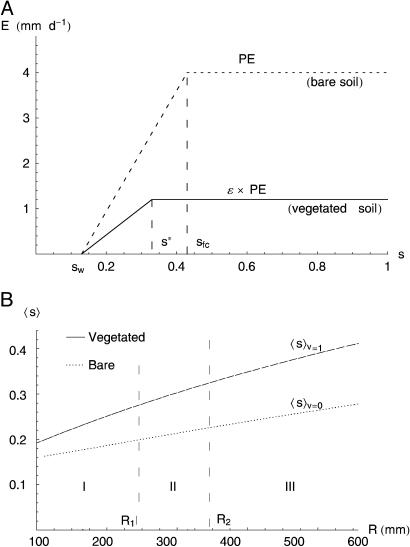Fig. 1.
Effect of vegetation on the soil water balance. (A) Dependence of evapotranspiration on (shallow) soil moisture. Bare-soil (i.e., V = 0) evaporation linearly increases from zero at the hygroscopic point, sh, to potential evaporation, PE, at field capacity, sfc (24), and remains constant for s ≥ sfc. In completely vegetated plots (i.e., V = Vmax), unstressed evapotranspiration occurs for s greater than a critical value s*. For s < s*, evapotranspiration linearly decreases, due to stomata regulation (19, 20, 25). E = 0 when s is less than the permanent wilting point, sw. Soil parameters are for sandy soils (sh ≅ sw = 0.13; s* = 0.33; sfc = 0.42). PE is 4 mm/d, and the maximum rate of evapotranspiration from the top 10 cm of soil (Z = 10 cm) is ε·PE with ε = 0.3. The use of different values of ε does not alter the general results of this study. (B) Average seasonal soil moisture calculated with Eq. 1 as a function of R for bare (〈s〉v=0) and completely vegetated (〈s〉v=1) soils. The other parameters (n = 0.38; Ks = 2,000 cm·d-1; β = 12.5, α = 10 mm·d-1; ε = 0.3, growing season length of 180 d) are typical of sandy soils and arid climates (e.g., ref. 20).

